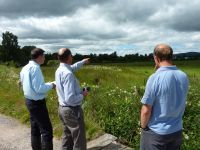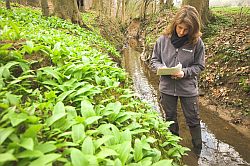News
SPIRAL "UK National Ecosystem Assessment" paper publshed
A new paper has been published based on work carried for SPIRAL, authored by Kerry Waylen and Juliette Young. This paper focuses on the first phase of the UK National Ecosystem Assessment.
Upcoming Event
No upcoming events.
SPIRAL Newsletter 2
Dear reader
![]() Welcome to the 2nd SPIRAL Newsletter. In this issue we will be giving an overview of the project's progress since the first Newsletter. We will also present two of the nine SPIRAL project partners.
Welcome to the 2nd SPIRAL Newsletter. In this issue we will be giving an overview of the project's progress since the first Newsletter. We will also present two of the nine SPIRAL project partners.
From now on, you can also follow SPIRAL on Twitter. Just add @SPIRAL_Project to your "following" list. The tweets can also be found on the home page of the SPIRAL website.
-------
Progress Reports
- Stocktaking and assessment of existing science-policy interfaces for biodiversity governance
- Factors constraining and facilitating communication on the role of biodiversity in underpinning livelihoods and ecosystem services
- Instruments for encouraging behaviour that reduces negative human impacts on biodiversity
- Designing and testing science-policy interfaces for biodiversity governance
Partner profiles:
-------
1. Stocktaking and assessment of existing science-policy interfaces for biodiversity governance
Work has progressed rapidly in terms of the mapping of the landscape of existing science-policy interfaces (SPI) on biodiversity. A Concept Note was drafted at the end of 2010, setting out the framework of analysis for the different case studies that SPIRAL will address and supporting the development of the adaptive design(s) that will be used for the test cases.
Following on from this work, SPI categories were developed in order to structure the vast SPI landscape and to get an overview of the range of different organizational approaches. Four generic SPI categories reflecting organizational structure were identified:
• interest group involved in science
• science project
• expert group
• state agency or institute
Within these generic categories six more fine-grained SPI categories based on SPI functions were added.
The mapping exercise has resulted in a database of 150 SPIs for biodiversity at different levels (selected EU-member states, the EU and the global level).
2. Factors constraining and facilitating communication on the role of biodiversity in underpinning livelihoods and ecosystem services
 A number of short discussions took place with scientists and policy-makers working on a range of biodiversity-related topics, in order to find out more about the factors that affect the communication of knowledge and ideas between scientists and policy-makers. In our discussions we aimed to find out their ideas about 'hot topics' where they thought communication between science and policy had been particularly problematic or interesting, and we scoped their ideas about key factors affecting communication.
A number of short discussions took place with scientists and policy-makers working on a range of biodiversity-related topics, in order to find out more about the factors that affect the communication of knowledge and ideas between scientists and policy-makers. In our discussions we aimed to find out their ideas about 'hot topics' where they thought communication between science and policy had been particularly problematic or interesting, and we scoped their ideas about key factors affecting communication.
These initial discussions resulted in 10 mini-reviews on topics ranging from biodiversity policy (e.g. Marine Protected Areas) to non-biodiversity policy (e.g. the Water Framework Directive). We also wrote mini-reviews on potential ways of conveying scientific information for use in policy-making (e.g. the UK National Ecosystem Assessment and Systematic reviews) and also on situations where biodiversity knowledge could be relevant at the very local scale (e.g. management of deer, or mountain hare).
We have now selected three areas where we will look at how knowledge, views and ideas are, or are not, communicated, and why. To ensure that we cover a range of issues, we are mandated to explore three areas of decision-making: national or international biodiversity policy, national or international policy not directly aimed at biodiversity, and local-level decision-making. To do this, we'll be conducting interviews with scientists and policy-makers related to each of three case-study areas, in order to explore their perceptions of how information and ideas are shared and conveyed, and what affects communication. Finally we're hoping to get their views and ideas on how best to improve the links between decision-makers and science. We'll be working on this over the autumn 2011 and will update you in the next newsletter.
3. Instruments for encouraging behaviour that reduces negative human impacts on biodiversity
 In March 2011, SPIRAL held a workshop in Brussels to draw out some complex research issues on how SPIs can influence behaviour in more or less successful ways, and how this can be assessed. The workshop drew on a ‘story telling’ session in which each participant described briefly his or her experience with a biodiversity-related science-policy interface, where a behavioural change was sought. The participants provided a very diverse range of stories, ranging from major international initiatives drawing on multiple research and policy communities (e.g. The Millennium Ecosystem Assessment, The Economics of Ecosystems and Biodiversity (TEEB) assessments), to specific national and local SPIs (e.g. Wetland restoration in lagoon of Venice), individual projects (Local nature protection in the Balkans), and SPIs focussing on a specific issue (e.g. Integrating biodiversity in development cooperation).
In March 2011, SPIRAL held a workshop in Brussels to draw out some complex research issues on how SPIs can influence behaviour in more or less successful ways, and how this can be assessed. The workshop drew on a ‘story telling’ session in which each participant described briefly his or her experience with a biodiversity-related science-policy interface, where a behavioural change was sought. The participants provided a very diverse range of stories, ranging from major international initiatives drawing on multiple research and policy communities (e.g. The Millennium Ecosystem Assessment, The Economics of Ecosystems and Biodiversity (TEEB) assessments), to specific national and local SPIs (e.g. Wetland restoration in lagoon of Venice), individual projects (Local nature protection in the Balkans), and SPIs focussing on a specific issue (e.g. Integrating biodiversity in development cooperation).
A few key issues to come out of the storytelling and discussions were that:
- Stakeholder involvement, clearly vital to the success of SPIs, is not straightforward. If some groups are disengaged, others may consider the SPI as biased. On the other hand, increasing the number of participants in SPIs may reduce the efficient operation of the SPI. Providing motivations for diverse groups of stakeholders to participate may be challenging.
- Key individuals - translators, champions and strong leaders - may all have important roles to play.
- Independence of SPIs from particular political objectives is important. Skilful balancing between independence, stakeholder involvement, and policy connections to achieve relevance (with policy connections), legitimacy (with stakeholder engagement) and credibility (with independence is a challenge.
- Formal evaluations are quite rare, but can be very useful. Performance should not be assessed too early, as the outcomes from SPI take time to emerge, but process-oriented evaluation can be useful at all stages.
Future work in SPIRAL will include further exploration of evaluation criteria and will consider the relevance of the criteria in different contexts, and in particular how the features of SPIs link to success or failure, and how different objectives may be traded off. This will involve interviews and a second workshop late in 2011 that will focus on testing these criteria.
4. Designing and testing science-policy interfaces for biodiversity governance
 In phase 4 of SPIRAL, running in parallel with the other actions of the project, we will be involved with the design, implementation and assessment of biodiversity science-policy interfaces with the aim of improving their effectiveness. We will do this by focusing on a number of real-life ‘test cases’, in which the project team will directly interact with a number of science-policy interfaces. This will allow hands-on testing, reality check, and feeding-back the teams’ expertise and results from other steps into the processes.
In phase 4 of SPIRAL, running in parallel with the other actions of the project, we will be involved with the design, implementation and assessment of biodiversity science-policy interfaces with the aim of improving their effectiveness. We will do this by focusing on a number of real-life ‘test cases’, in which the project team will directly interact with a number of science-policy interfaces. This will allow hands-on testing, reality check, and feeding-back the teams’ expertise and results from other steps into the processes.
Before the Summer of 2011, the project team agreed on the following list of test-cases that SPIRAL will support (subject to minor adjustments):
- The AfriBES Network - a social network of scientific and technical information on biodiversity and ecosystem services for Africa
- The recently established Intergovernmental Platform on Biodiversity and Ecosystem Services (IPBES)
- The EU mechanism of expertise
- The European initiative Science for Environmental Policy (SEPI)
- Marbef+
- Marcom
- The implementation of the Water Framework Directive in Romania
- The Royal Netherlands Institute for Sea Research (NIOZ)
- The Flemish Research Institute for Nature and Forest (INBO)
- HABC: ‘Human Adaptation to Biodiversity Change - Building and Testing Concepts, Methods, and Tools for Understanding and Supporting Autonomous Adaptation’ project
- The Society for Conservation Biology
- TEEB Phase 3
- The Model forest network.
These SPIs are operating at a variety of levels (sub-national, national, European and international) and in various contexts.
Currently, we are busy developing a “roadbook” in which we define our aims and approach to the test cases.
Phase 4 builds on the earlier identification of good practice and/or obstacles carried out in earlier steps (phase 1 to 3), giving us the benefit of a multi-aspect understanding of current strengths and weaknesses in science–policy interaction. We intend to build on what works and aim to overcome the major shortcomings identified in the earlier steps as well as in the test cases themselves. Particular attention is paid to the question of how to handle complexity and uncertainty in integrating scientific insights and principles into biodiversity policies; and how to integrate scientific, ethical, moral and stewardship principles, as well as economic concerns, into science-policy interfaces operation.
For each of the test cases, meetings with relevant actors and stakeholders will be organised to allow for strategic thinking about the adaptive strategy, evolution of the test-case and debriefing. A validation workshop will be held where the final reports on all test cases are presented to relevant actors and stakeholders.
PARTNER PROFILES
In each Newsletter we present two of the SPIRAL project partners. In this issue: The James Hutton Institute (UK) and the Research Institute for Nature and Forest (B).
 The James Hutton Institute was formed in April 2011 from the merger of the Macaulay Land Use Research Institute (MLURI) and the Scottish Crop Research Institute (SCRI), to combine their strengths in land-use and environmental research. The institute uses interdisciplinary approaches to work on key global issues such as food, energy and environmental security, and on technological and management approaches to tackle these issues.
The James Hutton Institute was formed in April 2011 from the merger of the Macaulay Land Use Research Institute (MLURI) and the Scottish Crop Research Institute (SCRI), to combine their strengths in land-use and environmental research. The institute uses interdisciplinary approaches to work on key global issues such as food, energy and environmental security, and on technological and management approaches to tackle these issues.
The JHI employs more than 600 scientists and support staff from a variety of natural and social science disciplines, making it one of the biggest research centres in the UK. It is based in two main sites in Scotland (at Aberdeen and Dundee) but works on projects across Scotland, Europe, and also in many developing countries. JHI places great importance on emphasising the relevance of its research to decision-makers at different scales and sectors, from policy-makers to land-managers. It therefore has particular expertise and interest in developing effective science-policy interfaces.
In case you wonder, the institute is named after James Hutton (1726 – 1797), who was a leading figure of the Scottish Enlightenment, an eighteenth century ‘golden age’ of intellectual and scientific achievements centred on Edinburgh. He is internationally regarded as the founder of modern geology and one of the first scientists to describe the Earth as a living system. His thinking on natural selection influenced Charles Darwin in developing his theory of evolution.
More information on the James Hutton Institute website.
The Research Institute for Nature and Forest
 The Research Institute for Nature and Forest (INBO) is the Flemish research and knowledge centre for nature and its sustainable management and use. INBO conducts research and supplies knowledge to all those who prepare or make the policies or are interested in them.
The Research Institute for Nature and Forest (INBO) is the Flemish research and knowledge centre for nature and its sustainable management and use. INBO conducts research and supplies knowledge to all those who prepare or make the policies or are interested in them.
As a leading scientific institute, INBO works for the Flemish government primarily, but also supplies information for international reporting and deals with questions from local authorities. In addition, INBO supports organisations for nature management, forestry, agriculture, hunting and fisheries. INBO is a member of national and European research networks. It makes its findings available to the general public.
INBO employs some 250 staff, mainly researchers and technicians. Besides its Brussels head office, INBO has branches in Geraardsbergen, Groenendaal and Linkebeek.
More information on the INBO website.




